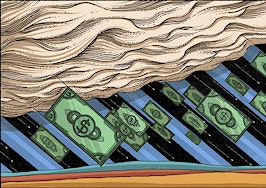Although inventory is still in short supply, many areas are experiencing price reductions and increased market times as interest rates climb. Historically, these events often harbinger a substantial correction in real estate prices.
What can you do to cope if prices take a plunge in your area? As real estate markets transition from a seller’s market to a flat or buyer’s market, you must shift your strategy to focus on how to deal with price depreciation rather than price appreciation.
Critical to this process is tracking the number of months of inventory available in each market area you serve. The reason this statistic is so important is that inventory declines precede price declines by six to 12 months.
Take the following steps to be even better prepared for the next market downturn.
1. Focus your prospecting on the most active areas
If you’re transitioning into a buyer’s market, identify the area(s) with the least amount of inventory and focus your prospecting efforts there.
The reason is that an area with four months of inventory has more buyers than an area with eight months of inventory. This means properties are more likely to sell and will be on the market for less time.
2. Prospect for first-time buyers
In a strong buyer’s market, first-time buyers may constitute up to half of all sales. An excellent place to prospect for these buyers is high-end rental apartments and rented houses. These individuals have nothing to sell and hence, are easier to close.
3. Focus on evergreen buyer niche markets
Listings always have been the name of the game. Nevertheless, when there are eight or more months of inventory on the market in a given price range, it’s time to focus on generating buyer leads.
The challenge is that buyers in these markets are in short supply, especially if they don’t have to sell. Hold more open houses, work with a relocation company, prospect for newly married individuals or work with divorcing couples.
The objective is to work with individuals who have the highest probability of buying.
4. Master what the numbers mean for your sellers
In my experience, the most powerful strategy for coping with plummeting prices is called, “The probability of selling.” This is also sometimes referenced as the “rate of absorption.”
Being able to explain absorption rates and how they impact prices is the first step in getting sellers to be realistic about their prices. Here’s how to do it:
- Begin by searching your multiple listing service (MLS) for how many months of inventory are on the market.
- Assume the number is eight (i.e., if no new listings come on the market, it would take eight months for 100 percent of the current inventory to sell).
- This means 12.5 percent of the listed properties will sell each month and 87.5 percent will not sell.
5. Show sellers the benefit of selling now
In the early 1990s, the luxury market in Beverly Hills, Brentwood and Bel Air took a 33 percent drop in about six months.
In the midst of this price plunge, one of my buyers offered $1.1 million on a property listed at $1.35 million. The owner was Tokyo-based developer, Haseko.
Haseko countered at $1.325 million and told us they were firm on that price. The buyer raised his offer to $1.125 million and was unwilling to go any higher because prices were declining so quickly.
Haseko decided that they would wait for another offer.
At that point, I researched exactly how many months of inventory were on the market in that area — the number was 60 (that’s the equivalent of five years of inventory).
Here’s what I included in my letter to Haseko explaining why they should take my buyer’s offer:
- The rate of absorption was 1.6 percent (1 sale every 60 months). In other words, the probability that the property would sell was 1.6 percent in any month, and the probability it would not sell in a given month was 98.4 percent.
- At the time I wrote the offer, the rate of decline for the previous six months was 3 percent per month. Consequently, each month their property stayed on the market, it was losing $40,500 in value ($1,350,000 x 3 percent).
- If it took them another six months before they received their next offer, their property would have declined by $243,000 and would be worth $1,107,000, $18,000 less than my buyer was offering.
- In addition to the price decline, they also had the carrying costs including property taxes, insurance, HOA fees, etc.
The reduction from the original price had to be approved by Haseko’s board of directors in Tokyo. Fortunately, they recognized the risk, and we closed the transaction at $1.125 million.
To prosper in a down market you must be able to show your sellers the benefits of selling now and locking in a price rather than taking the risk that their property will be worth less if they wait.
Working with the rate of absorption and the months of inventory on the market is one of the most effective ways to do this.
Bernice Ross, President and CEO of BrokerageUP (brokerageup.com) and RealEstateCoach.com, is a national speaker, author and trainer with over 1,000 published articles. Learn about her broker/manager training programs designed for women, by women, at BrokerageUp.com and her new agent sales training at RealEstateCoach.com/newagent.









